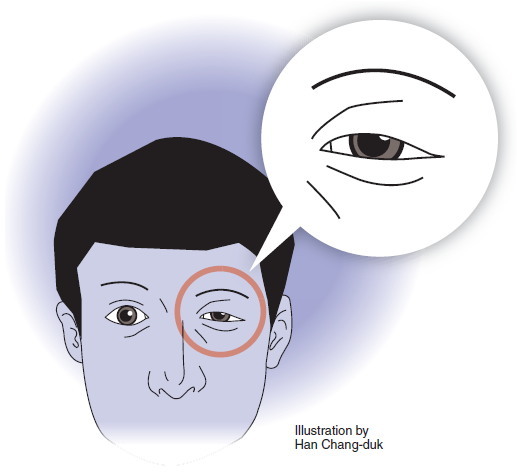Ptosis is a condition where the eye appears small and sleepy due to an abnormal drooping of the upper eyelid when looking straight. There is congenital ptosis where a drooping of the eyelid is present from birth; it can also be acquired with age as well as being a secondary effect of trauma or a disorder. It is treatable by surgery depending on the patient’s condition.
Cause
Congenital ptosis occurs when the levator palpebrae muscle that raises the eyelid is not strong enough due to abnormal development. It is associated with systemic myogenic or neurological disorders in rare occasions. It may also be associated with a hereditary disorder but is more often idiopathic.
Causes of acquired ptosis include age-related change, damage or weakness of the levator palpebrae muscle due to trauma, neurological disorders and systemic diseases.

Signs and symptoms
When your vision is impaired, you strain your forehead to see an object. As a result, wrinkles form on your forehead, both of your eyebrows move up and you lift your chin up to see the object. In children, the most significant problem is that an amblyopia (lazy eye) may develop as a result of abnormal visual development if there is a severe drooping of the eyelid.
Children with ptosis of the eyelids should have a thorough examination to check for amblyopia. In addition, the eye with ptosis is likely to have refractive abnormalities such as astigmatism or strabismus (squint), which might affect amblyopia.
If a child has amblyopia in one eye and is not using the affected eye much, surgical intervention may be required for ptosis even at a young age.
Treatment
The surgical method is decided by the degree of ptosis and the function of the eyelid-raising muscle (levator palpebrae muscle). Repositioning of the levator palpebrae aponeurosis, resection of the levator palpebrae muscle, a frontalis sling operation or Muller’s muscle-conjunctival resection can be performed. Sometimes blepharoplasty of the eyelid, which corrects defects of the eyelid, may also be required.
Post-operatively, the patient may experience symptoms such as incomplete eyelid closure when sleeping and lid lag (the upper eyelid not moving downward) when looking down. However, these symptoms usually recover gradually with time. The likelihood of the symptoms is dependent on the function of the patient’s eyelid prior to surgery, so a detailed consultation is required. It is essential to protect the eye by applying eyedrops or cream properly after the surgery.
As most ptosis cases are either congenital or acquired with age, there is no particular prevention. However, in some acquired ptosis, long-term use of hard contact lenses can develop minor ptosis. Therefore, the use of contact lenses for an unreasonably long period of time must be avoided and gentle manipulation is required when removing the lens.
Cause
Congenital ptosis occurs when the levator palpebrae muscle that raises the eyelid is not strong enough due to abnormal development. It is associated with systemic myogenic or neurological disorders in rare occasions. It may also be associated with a hereditary disorder but is more often idiopathic.
Causes of acquired ptosis include age-related change, damage or weakness of the levator palpebrae muscle due to trauma, neurological disorders and systemic diseases.

Signs and symptoms
When your vision is impaired, you strain your forehead to see an object. As a result, wrinkles form on your forehead, both of your eyebrows move up and you lift your chin up to see the object. In children, the most significant problem is that an amblyopia (lazy eye) may develop as a result of abnormal visual development if there is a severe drooping of the eyelid.
Children with ptosis of the eyelids should have a thorough examination to check for amblyopia. In addition, the eye with ptosis is likely to have refractive abnormalities such as astigmatism or strabismus (squint), which might affect amblyopia.
If a child has amblyopia in one eye and is not using the affected eye much, surgical intervention may be required for ptosis even at a young age.
Treatment
The surgical method is decided by the degree of ptosis and the function of the eyelid-raising muscle (levator palpebrae muscle). Repositioning of the levator palpebrae aponeurosis, resection of the levator palpebrae muscle, a frontalis sling operation or Muller’s muscle-conjunctival resection can be performed. Sometimes blepharoplasty of the eyelid, which corrects defects of the eyelid, may also be required.
Post-operatively, the patient may experience symptoms such as incomplete eyelid closure when sleeping and lid lag (the upper eyelid not moving downward) when looking down. However, these symptoms usually recover gradually with time. The likelihood of the symptoms is dependent on the function of the patient’s eyelid prior to surgery, so a detailed consultation is required. It is essential to protect the eye by applying eyedrops or cream properly after the surgery.
As most ptosis cases are either congenital or acquired with age, there is no particular prevention. However, in some acquired ptosis, long-term use of hard contact lenses can develop minor ptosis. Therefore, the use of contact lenses for an unreasonably long period of time must be avoided and gentle manipulation is required when removing the lens.

By Woo Kyung-in
The author is a doctor at Samsung Medical Center and a professor of ophthalmology at Sungkyunkwan University’s School of Medicine. ― Ed.







![[Graphic News] More Koreans say they plan long-distance trips this year](http://res.heraldm.com/phpwas/restmb_idxmake.php?idx=644&simg=/content/image/2024/04/17/20240417050828_0.gif&u=)
![[KH Explains] Hyundai's full hybrid edge to pay off amid slow transition to pure EVs](http://res.heraldm.com/phpwas/restmb_idxmake.php?idx=644&simg=/content/image/2024/04/18/20240418050645_0.jpg&u=20240419100350)





![[From the Scene] Monks, Buddhists hail return of remains of Buddhas](http://res.heraldm.com/phpwas/restmb_idxmake.php?idx=652&simg=/content/image/2024/04/19/20240419050617_0.jpg&u=20240419175937)

![[KH Explains] Hyundai's full hybrid edge to pay off amid slow transition to pure EVs](http://res.heraldm.com/phpwas/restmb_idxmake.php?idx=652&simg=/content/image/2024/04/18/20240418050645_0.jpg&u=20240419100350)

![[Today’s K-pop] Illit drops debut single remix](http://res.heraldm.com/phpwas/restmb_idxmake.php?idx=642&simg=/content/image/2024/04/19/20240419050612_0.jpg&u=)